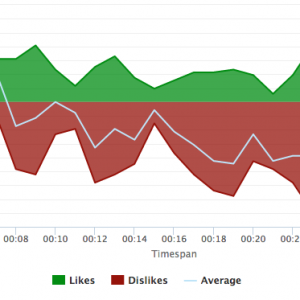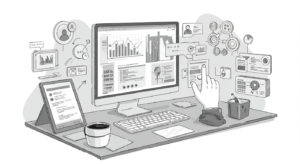Unlocking the Power of AI in Market Research

Market research has undergone significant transformations in the past few years, especially with the emergence of machine learning and data analytics. Traditional market research methods have been rendered obsolete, and businesses are now turning towards Artificial Intelligence (AI) tools and platforms. Big data has revolutionized market research, providing organizations with the ability to capture and analyze large volumes of data quickly.
The Evolution of Market Research
The world of market research has come a long way since its inception. Traditionally, market research involved conducting surveys, focus groups, and collecting data on consumer preferences. Over time, businesses collaborated with third-party research firms to gather insights about their customers. In recent years, however, the market research industry has rapidly evolved to better serve businesses.
Traditional Market Research Methods
Traditional market research methods were cumbersome and time-consuming. Researchers had to work with large sample sizes to ensure results were accurate and representative. Focus groups and interviews required a physical presence, so businesses needed to coordinate venues for the sessions, which was costly and time-consuming. Additionally, businesses had to wait for weeks or months to receive data analysis reports, which led to ineffective decision-making.
Despite the challenges, traditional market research methods were effective in providing businesses with valuable insights into their customers’ preferences and behaviors. However, as technology advanced, businesses began to realize the limitations of traditional market research methods and started looking for more efficient and cost-effective ways to collect data.
The Emergence of AI in Market Research
Artificial Intelligence has played a significant role in transforming the market research industry. AI-enabled platforms can now store, process, and analyze large volumes of data incredibly quickly. AI has made market research cost-effective, time-efficient, and accurate.
AI-powered market research tools can analyze vast amounts of data from various sources, including social media, customer feedback, and online reviews. This allows businesses to gain insights into customer preferences and behaviors in real-time, enabling them to make data-driven decisions quickly. Furthermore, AI can identify patterns and trends in consumer behavior that may not be apparent through traditional market research methods.
Another benefit of AI in market research is that it can provide businesses with personalized insights. By analyzing individual customer data, AI can provide businesses with tailored recommendations on how to improve their products or services to meet customers’ needs better. This level of personalization was not possible through traditional market research methods, which relied on aggregated data.
Overall, the emergence of AI in market research has revolutionized the way businesses collect and analyze data. AI has made market research more accessible, cost-effective, and accurate, enabling businesses to gain valuable insights into their customers’ preferences and behaviors in real-time.
Key AI Technologies Transforming Market Research
Several AI technologies have transformed the market research industry, providing businesses with accurate insights about their customers. With the help of these technologies, businesses are able to understand their customers better and make informed decisions about their products and services.
Natural Language Processing (NLP)
NLP is an AI technology that allows computers to analyze human language. It helps businesses to understand written or spoken language, and even to interpret emotions and context. NLP is particularly useful in survey tools, where it can help businesses to understand open-ended responses. With the help of NLP, businesses can gain a deeper understanding of their customers’ needs, preferences, and opinions.
For instance, a company that sells skincare products can use NLP to analyze customer feedback about their products. By analyzing the feedback, the company can identify common issues that customers face and improve their products accordingly. This can lead to increased customer satisfaction and loyalty.
Machine Learning and Predictive Analytics
Machine learning and predictive analytics are AI technologies that use algorithms to analyze data and identify patterns that are too complex for humans to see. Machine learning algorithms learn from data and can predict future behavior based on patterns they have identified. This technology is particularly useful in detecting patterns in unstructured data like social media feeds and customer chat logs.
For example, a company that sells pet food can use machine learning and predictive analytics to analyze customer data and identify patterns in their purchasing behavior. By analyzing the data, the company can identify which products are most popular among their customers and adjust their marketing strategies accordingly. This can lead to increased sales and revenue.
Sentiment Analysis
Sentiment analysis is a form of NLP that uses machine learning algorithms to detect emotions, attitudes, opinions, and feelings from unstructured data sources. Sentiment analysis helps businesses determine the overall sentiment of customers towards their brand, products, and services.
For instance, a company that provides online tutoring services can use sentiment analysis to analyze customer feedback about their services. By analyzing the feedback, the company can identify areas where they need to improve and make changes accordingly. This can lead to increased customer satisfaction and loyalty.
Image and Video Recognition
Image and video recognition is an AI technology that identifies objects, people, or visual patterns within still or moving images. This technology is particularly useful in industries that rely on visual content, such as fashion or automotive, where businesses can identify popular trends or customer preferences.
For example, a company that sells fashion accessories can use image recognition to analyze customer photos on social media and identify which products are most popular among their customers. By analyzing the data, the company can adjust their product offerings and marketing strategies accordingly. This can lead to increased sales and revenue.
Overall, AI technologies have revolutionized the market research industry, providing businesses with powerful tools to understand their customers better and make informed decisions about their products and services. As AI continues to evolve, we can expect to see even more innovative applications of these technologies in the future.
Benefits of AI in Market Research
AI-enabled market research has revolutionized the way businesses make decisions. AI-powered tools and platforms offer several benefits over traditional research methods. In this article, we will explore some of the key benefits of AI in market research.
Improved Accuracy and Efficiency
AI technologies have significantly improved the efficiency and accuracy of market research. AI algorithms can process vast amounts of data in less time, and provide accurate insights into customer behavior. This means that businesses can make more informed decisions based on reliable data, without having to spend countless hours analyzing data manually.
For example, AI-powered tools can analyze customer feedback from various sources, such as social media, online reviews, and customer surveys, and identify patterns and trends in customer behavior. This allows businesses to gain a better understanding of their customers’ needs and preferences, and tailor their products and services accordingly.
Enhanced Customer Insights
AI-powered platforms provide businesses with more in-depth insights into customer behavior than traditional research methods. AI algorithms can process vast amounts of data from multiple sources and provide insights into customer preferences, sentiments, and behaviors.
Moreover, AI-powered tools can analyze unstructured data, such as text and images, and extract valuable insights from it. For instance, sentiment analysis algorithms can analyze customer reviews and identify the emotions and opinions expressed by customers toward a product or service. This information can help businesses improve their products and services and enhance customer satisfaction.
Real-time Data Analysis
AI-powered market research tools offer real-time data analysis, enabling businesses to make decisions on-the-go. This capability ensures that businesses can stay up-to-date with current trends and customer preferences to stay ahead of the competition.
For example, AI-powered tools can monitor social media platforms and news outlets to identify emerging trends and topics related to a business’s industry. This allows businesses to quickly adapt to changing market conditions and customer needs, and make informed decisions based on real-time data.
Cost Reduction and Time Savings
AI-enabled market research is more cost-effective and time-efficient compared to traditional research methods. Businesses can save a significant amount of time and money by utilizing AI-powered tools which process data faster and provide more accurate insights.
For instance, AI-powered tools can automate data collection and analysis, eliminating the need for manual data entry and analysis. This saves businesses time and resources, allowing them to focus on other important tasks, such as product development and customer engagement.
In conclusion, AI-enabled market research offers several benefits over traditional research methods. By utilizing AI-powered tools and platforms, businesses can gain more accurate and in-depth insights into customer behavior, stay up-to-date with current trends, and make informed decisions based on real-time data.
AI-Powered Market Research Tools and Platforms
Market research is an essential aspect of any business that wants to stay ahead of its competitors. It involves collecting and analyzing data to gain insights into customer preferences, behaviors, and sentiments. With the emergence of AI-powered tools and platforms, market research has become more efficient and effective. Let’s take a closer look at some of these tools and platforms.
Survey and Polling Tools
Survey and polling tools are essential for businesses that want to collect data quickly and efficiently. These tools use natural language processing (NLP) to understand open-ended responses, making it easier for businesses to analyze the data. Additionally, survey and polling tools offer various delivery mechanisms, such as email, SMS, and social media, allowing businesses to reach a wider audience. With data processing capabilities, these tools can provide valuable insights into customer preferences and sentiments, helping businesses make data-driven decisions.
For example, a restaurant owner can use a survey tool to understand customer preferences for different cuisines, dietary restrictions, and preferred dining times. By analyzing the data collected, the owner can make informed decisions about menu offerings, special promotions, and opening hours.
Social Media Listening Tools
Social media has become a powerful tool for businesses to connect with their customers. However, with millions of conversations happening every day, it can be challenging to keep track of what people are saying about your brand, products, and services. This is where AI-powered social media listening tools come in.
These tools use machine learning algorithms to analyze social media conversations and identify patterns and trends. They can track mentions of your brand, identify influencers, and even predict future trends. By analyzing the data collected, businesses can gain valuable insights into customer sentiments and preferences and make data-driven decisions.
For example, a fashion retailer can use a social media listening tool to track conversations about their brand and identify influencers who are promoting their products. By analyzing the data collected, the retailer can understand customer preferences for different styles, colors, and fabrics, and make informed decisions about future product offerings.
Data Visualization and Reporting Tools
Collecting data is one thing, but making sense of it is another. Data visualization and reporting tools enable businesses to convert complex data into easy-to-understand graphs, charts, and infographics. These tools can help businesses identify trends, patterns, and outliers in the data, making it easier to understand customer preferences and behaviors.
For example, an e-commerce retailer can use a data visualization tool to create a graph that shows the percentage of customers who abandon their shopping carts at different stages of the checkout process. By analyzing the data, the retailer can identify the most common reasons for cart abandonment, such as high shipping costs or a complicated checkout process, and make changes to improve the customer experience.
In conclusion, AI-powered market research tools and platforms have revolutionized the way businesses collect and analyze data. By using these tools, businesses can gain valuable insights into customer preferences and behaviors, allowing them to make data-driven decisions and stay ahead of their competitors.
Conclusion
AI has transformed the market research industry, offering businesses accurate, time-efficient, and cost-effective ways to understand customer behavior. AI-powered platforms and tools allow businesses to stay ahead of the competition by providing real-time data analysis, enhanced customer insights, and faster decision-making. With the availability of AI technologies and companies like Spot Trender, organizations worldwide can unlock the power of their data and harness actionable insights to drive growth.








